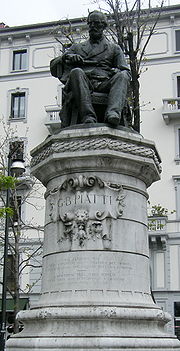Giovanni Battista Piatti

Giovanni Battista Piatti (Milan, February 10, 1812 - Milan, September 4, 1867) was an Italian civil engineer.
Civil engineer from Milan, inventor of the pneumatic rock-drilling machine that, with small modifications, was used in the Mont Cenis Tunnel. On the February 12, 1853 he conceived how to face the excavation work, being based on the application of the compressed air, and published: Proposal for the railroad between Susa and Modane of a new system of propulsion with air compressed hydraulic motors (system experimented in England) and first draft of plan for excavation of the Alps.
He was disowned while still alive, since the invention was patented by Germain Sommeiller, but its work was recognized, especially by the architect Luca Beltrami and thanks to the admirers who constructed a monument dedicated to him in Milan, at Largo La Foppa, remembering that: «in February 1853 he was the first to propose for the Mont Cenis Tunnel original and practical applications of compressed air, [thus] distinguishing himself in that demanding enterprise».
Bibliography
- Giovanni Battista Piatti, Proposta per la strada ferrata tra Susa e Modane di un nuovo sistema di propulsione ad aria compressa da motori idraulici (sistema esperimentato in Inghilterra) e abbozzo di progetto pel traforamento delle Alpi, Turin, Castellazzo e Gabetti, 1853 (52 p., with 3 tables)
